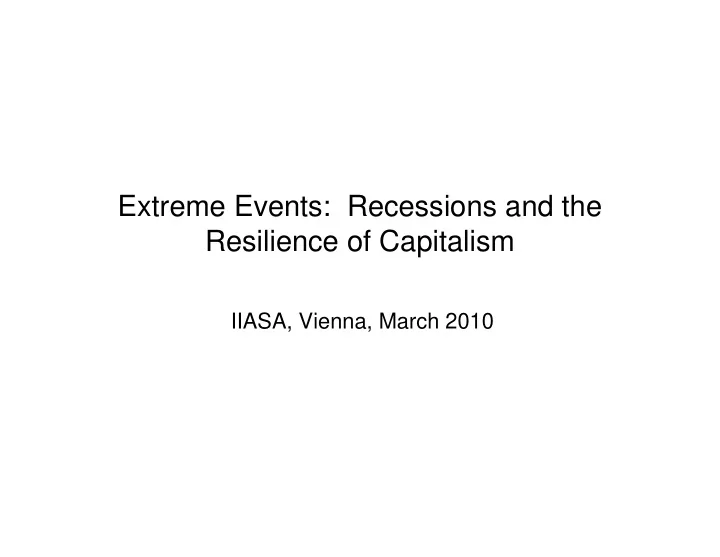

Extreme Events: Recessions and the Resilience of Capitalism IIASA, Vienna, March 2010
Overview • Definitions and data • Size and duration of recessions • Patterns of recovery • What are the ‘stylised facts’? • What are the implications for economic theory?
Recessions • Conventional definition: with annual data, when growth of real GDP is less than zero • A major shock: unemployment rises, firms fail • Results are robust to an alternative definition: a period of successive years during which the level of real GDP remains below its previous peak • Annual data available for 17 Western economies from 1871 to present (source is mainly A Maddison, Monitoring the World Economy 1820–1992 , OECD, Paris, 1995 • P Ormerod in Risk Management , January 2010 and www.paulormerod.com
Pooling the Data • The annual data from 17 countries is pooled • Heterogeneity of data w.r.t. size is tested • Pair wise Kolmogorov-Smirnov tests of null hypothesis that distribution of size of recession in country k is the same as country m • There are 136 such pair-wise tests, and the null hypothesis is rejected at a p-value of less than 0.05 in only 5 cases • It is therefore reasonable to assume that the pooled data across countries is homogeneously distributed • This avoids statistical complications in pooling • More importantly, suggests that there are features which are common to recessions across countries.
Cumulative fall in GDP, per cent, all recessions since 1871 17 Western countries 60 40 freq 20 0 0 10 20 30 40 50 60 per cent
Recovery after world wars • There are some truly extreme shocks with cumulative output falls of more than 50 per cent • Recovery to pre-war GDP levels was quite rapid • Date that 1938 GDP levels were reached and maximum fall below 1938 level Fall % Date Germany 58 1951 Japan 50 1951 Italy 44 1949 Austria 59 1950 France 53 1949
Date that 1913 GDP levels were reached and maximum fall below 1913 level Fall% Date Germany 12 1925 UK 23 1925 France 33 1923
Table 1 Duration of recession, years, i.e. number of consecutive years in which real GDP growth is less than zero Years 1 2 3 4 5 6 7 Number 164 58 20 6 5 1 1
Distribution of duration of recessions • NB small sample size • Benchmark exponential: is consistent with the assumption in mainstream macroeconomic theory that business fluctuations are driven by recurring identically independently distributed random shocks, so that the duration of the cycle should be independent of length. • Null hypothesis of exponential with rate parameter 0.07 rejected at p = 0.62 • But a Weibull with shape 0.61 at p = 0.97 • Very tentative evidence that the longer it lasts, the more likely it is to go on (Keynes’ animal spirits)
Size of recession, excl. WW1 and WW2, actual and fitted non-linear least squares Weibull estimation 30 25 20 size 15 10 5 0 0 5 10 15 20 25 30 fitted
Patterns of recovery • Focusing on recessions since the Second World War, and using annual data, an analysis of a total of 37 recessions (to 2008) in 17 countries suggests that for recessions with only short duration, the typical recovery pattern is rapid. The average growth rate in the year after the recession was 3.5 per cent, and in the subsequent year 3.8 per cent. • Post-war data suggest, however, that once a recession is prolonged and lasts for 2 or more years, recovery is rather more hesitant. (We only have 12 examples since 1947)
Recovery profile (1) One year recessions in the West since 1947 130 Index, pre-recession GDP = 100 120 110 100 1 2 3 4 5 6 7 years
Recovery profile (2) All 2 and 3 year recessions in the West since 1947 120 Index, pre-recession year = 100 110 100 90 1 2 3 4 5 6 7 8 9 10 years
The Great Depression recovery profile • The experience of the Great Depression itself varied enormously across countries, • However, once the recovery began – in different calendar years in different countries – the average rate of growth was strong, though less than that seen after 1 year recessions in the inter-war period. • GDP growth in the first year after the Great Depression average 4.7 per cent, followed by 4.6 per cent in both the second and third years. • The 1 year recessions in the inter-war period: in the first year of recovery, output growth averaged 7.8 per cent, followed by 4.8 per cent in the second year
Hypothesis • Most recessions under capitalism are short-lived. • A plausible reason for this is that most recessions are essentially inventory cycles. • During the upswing, businesses tend to become too optimistic about future prospects. As a result, production begins to run ahead of sales and inventory levels rise. Firms then cut back on production in order to restore inventories to more reasonable levels. As part of this process, fixed investment projects may be postponed. • Temporary reductions in capital expenditure plus actions to reduce inventory levels are of themselves inherently of short duration. The adjustment takes place quickly.
But • Non-Gaussian nature of data suggests that interaction amongst heterogeneous agents is a feature • Suggestions to support Keynes’ view of psychological nature of recessions, ‘animal spirits’ • The longer it goes on, the bigger it is, the more likely it is to persist. And the slower and weaker (relatively) is the recovery
Recommend
More recommend